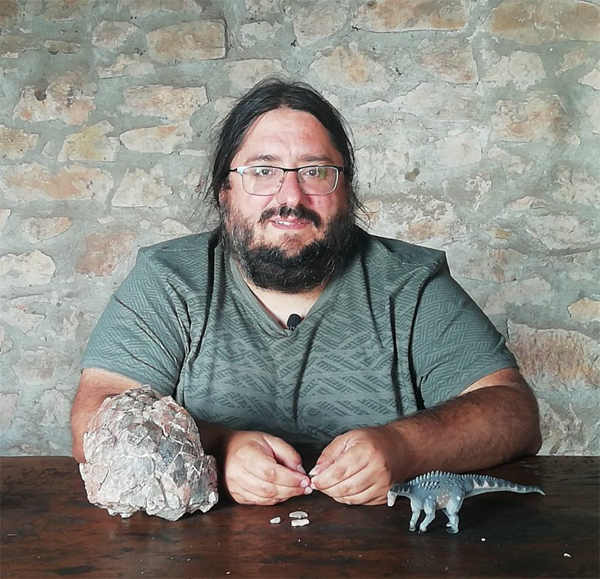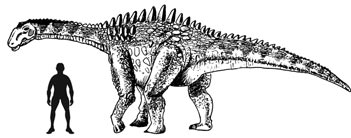A new species of Late Jurassic iguanodontian was recently announced. Hesperonyx martinhotomasorum from the Lourinhã Formation of western Portugal demonstrates that this part of Europe was home to a highly diverse dinosaur dominated ecosystem. Everything Dinosaur corresponded with the scientific paper’s lead author Filippo Maria Rotatori (Universidade NOVA de Lisboa) so that we could obtain the media release about this exciting dinosaur discovery. We spotted a CollectA Prehistoric Life Ampelosaurus in one of the photographs submitted.
One of the paper’s co-authors and the supervisor of Filippo, Miguel Moreno-Azanza was photographed with a titanosaur egg fossil and a CollectA Ampelosaurus figure.

Miguel Moreno-Azanza, from Zaragoza University, co-author of the Hesperonyx scientific paper with a titanosaur egg fossil and an Ampelosaurus model. The CollectA Prehistoric Life Ampelosaurus features in this image. Picture credit: Universidade NOVA de Lisboa.
The CollectA Prehistoric Life Ampelosaurus
Postdoctoral Fellow Miguel Moreno-Azanza is an authority on fossilised eggs and fossil eggshells. A photograph submitted with the Hesperonyx media release includes the CollectA Prehistoric Life Ampelosaurus and a specimen of a titanosaur egg. Team members presume the CollectA model was included in the image to demonstrate what a titanosaur looks like. When visiting preparation laboratories and museums we do tend to see lots of prehistoric animal models including figures from the CollectA Prehistoric Life range.
The CollectA Ampelosaurus figure was introduced in 2012. It was designed by Anthony Beeson. This titanosauria sauropod was formally named and described in 1995 (Ampelosaurus atacis). Fossils come from outcrops of the lower levels of the Marnes Rouges Inférieures Formation in the French Pyrenees. Ampelosaurus is estimated to have measured around fourteen to sixteen metres in length. It may have weighed fifteen tonnes. Although much larger than any extant terrestrial animal, Ampelosaurus was relatively small compared to other Late Cretaceous titanosaurs.
During the Late Cretaceous sea levels were extremely high. Much of the European landmass was submerged. Ampelosaurus lived on the Ibero-Armorican island, a large island made up of southern France and the Iberian Peninsula. Ampelosaurus fossil material is associated with the early Maastrichtian faunal stage of the Late Cretaceous. It lived approximately 71-70 million years ago. The genus name translates as “vine lizard”. Some of the first fossils to be studied were discovered close to the Blanquette de Limoux vineyard. This part of the French Pyrenees is renowned for its fine sparkling wine.
To view the range of CollectA Prehistoric Life figures in stock at Everything Dinosaur: CollectA Dinosaur and Prehistoric Animal Models.

A typical European titanosaur (Ampelosaurus atacis) from the Late Cretaceous. Picture credit: Everything Dinosaur.
Picture credit: Everything Dinosaur
Spotting the Ampelosaurus Model
A spokesperson from Everything Dinosaur commented that many academics, palaeontologists and scientists source their models from Everything Dinosaur. Many collect figures including the CollectA Prehistoric Life model range. However, these models are also used in science communication projects.
The spokesperson added:
“When discussing titanosaur eggs and other titanosaur fossil material it is helpful to have a titanosaur dinosaur model on hand. Members of the public can get an impression of what the dinosaur looked like.”
Visit the Everything Dinosaur website: The Everything Dinosaur Website.
To read the article about the discovery of the new European iguanodontian dinosaur: A New Iguanodontian Dinosaur from Western Portugal.
What other prehistoric animal models will be spot in future media releases?







Leave A Comment